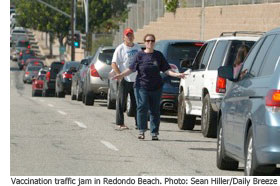Confronting H1N1 rollout concerns
November 10, 2009
As members of the Board of Supervisors on Tuesday detailed a litany of concerns about the rollout of the county’s H1N1 vaccination program, public health officials announced steps they are taking to address the problems, including establishing more large regional clinics, making lines move faster by screening patients earlier and finding ways to better reach African Americans who so far appear to be under-represented in the ranks of the inoculated. 
During the board’s weekly meeting, Supervisor Zev Yaroslavsky acknowledged the difficulty of the department’s task. “The bottom line of all this is that you just don’t have enough vaccine,” the supervisor said. But he also urged health officials to focus attention on holding more clinics in the mid- and eastern San Fernando Valley. After the board’s session, public health officials said clinics are scheduled for Panorama and Sunland.
Supervisor Mark Ridley-Thomas said he was troubled that African Americans are not being vaccinated at a rate that reflects their presence in the population. “What has happened to date is not acceptable,” Ridley-Thomas said, adding that he has “very substantial concerns that I expect will be addressed in short order.”
Dr. Jonathan Fielding, the county’s director of public health, said the department is still analyzing the demographic data but that he, too, is troubled by the black turnout, which he said could be partly attributed to mistrust of the vaccine itself, as well as to historical distrust of such programs.
After the meeting, Fielding said he could not yet release demographic information on who’s received shots so far. “We have very gross data that is subject to misinterpretation,” he said. He added, however, that concerns about the under-vaccination of African Americans are certainly valid.
Overall, Fielding said, there have been 74 H1N1 deaths in the county and 200 hospitalizations last week alone. He said he believes the outbreak is “at or near its peak” but that it is difficult to know for sure.
In all, the county has received 810,000 doses of vaccine so far, with 538,000 of those going to private providers and the rest to the Department of Public Health. Of the county’s allotment, 113,000 vaccinations have been given in 69 county H1N1 clinics.
Although vaccine shortages are easing somewhat, Fielding said, the “current supply is inadequate.”
Officials estimate there are 5.5 million people in Los Angeles County who fall into high-risk categories for the infection, commonly known as the swine flu. Millions more should get the injections as well, after the high-risk population has been inoculated.
The shortages have thrown a major kink into the county’s vaccination plan, which in some respects was based on disaster preparedness models set up to handle public health emergencies such as an anthrax attack. Because both vaccine supply and turnout have been highly unpredictable, some clinics have been lightly attended while others have been overwhelmed, with up to 3,000 people queuing for hours.
A drive-up clinic in Redondo Beach created traffic havoc; Board of Supervisors Chairman Don Knabe described it on Tuesday as “just catastrophic.”
Later this week, public health officials will post their latest list of vaccine clinics on the department’s website. They noted that they have shifted their emphasis away from smaller neighborhood events toward large-scale, regional clinics where traffic, parking, public awareness of the site and medical logistics can be better managed.
An advertising campaign, tabled when the vaccine shortages appeared, will also be revived in coming weeks. That may help target African American communities, though Fielding said it will be important as well to enlist “spokespeople with the trust of the community” to spread the word, too.
Public health officials also are trying to cut down on long waiting times with “early line management”—taking medical history information from patients and determining which of several modes of inoculation would be most suitable for each, even before clinic doors open.
“It’s complicated in real time when you have people waiting to be immunized,” Fielding said, noting the array of vaccine variables: nasal mist, injections, multiple dosage packaging, single dosage packaging, with preservatives and without.
Health workers have also started moving through clinic lines to let those waiting know how much vaccine will be available at a given site and to divert lower-priority patients to later sessions.
Even the high-risk classifications themselves can change; Fielding said today that morbid obesity has now been added to the priority group list.
After the meeting, Jonathan E. Freedman, chief deputy of the Department of Public Health, said that even with all the obstacles, the pace of the H1N1 vaccination program in just a few weeks has outstripped the usual 60,000 to 70,000 injections that would be administered during a typical flu season.












 405 bridge work causes a stink
405 bridge work causes a stink
